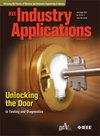考虑空间谐波、匝间短路故障和零序分量的永磁同步电动机建模
IF 4.5
2区 工程技术
Q2 ENGINEERING, ELECTRICAL & ELECTRONIC
引用次数: 0
摘要
提出了一种考虑空间谐波、匝间短路故障和零序分量的永磁同步电机转子位置相关(RPD)模型。首先,得到健康机模型。忽略磁饱和,使得机器电感仅依赖于转子位置,允许使用傅里叶级数相对直接地推导磁链、转矩、电流和转子位置之间的关系。其次,在假设故障匝数在槽内精确位置的影响可以忽略的情况下,建立了故障机转子位置依赖模型;第三,对槽内故障匝的精确位置的影响进行了评估。最后,利用Gmsh/GetDP中的有限元模型和IPMSM复卷的实验结果对转子位置依赖模型进行了验证,以实现匝间短路的仿真。并与常规的常参数模型进行了比较。本文章由计算机程序翻译,如有差异,请以英文原文为准。
Modeling of PMSMs Considering Spatial Harmonics, Interturn Short-Circuit Faults, and Zero-Sequence Components
This paper presents a rotor-position dependent (RPD) model for permanent-magnet synchronous machines (surface-mounted or interior permanent-magnet) considering both space harmonics, interturn short-circuit faults and zero-sequence components. First, the healthy machine model is obtained. Magnetic saturation is disregarded such that the machine inductances depend only on the rotor position, allowing for a relatively straightforward derivation of the relations between flux-linkages, torque, currents, and rotor position using Fourier series. Secondly, the faulty machine rotor-position dependent model is derived assuming that the effect of the precise location of the faulty turns inside the slot is negligible. Thirdly, the impact of the precise location of the faulty turns inside the slot is evaluated. Finally, the rotor-position dependent model is validated with a finite-element model in Gmsh/GetDP and with experimental results obtained with an IPMSM rewound to allow emulation of interturn short-circuit. Comparison with the conventional constant-parameter (CP) model is also provided.
求助全文
通过发布文献求助,成功后即可免费获取论文全文。
去求助
来源期刊

IEEE Transactions on Industry Applications
工程技术-工程:电子与电气
CiteScore
9.90
自引率
9.10%
发文量
747
审稿时长
3.3 months
期刊介绍:
The scope of the IEEE Transactions on Industry Applications includes all scope items of the IEEE Industry Applications Society, that is, the advancement of the theory and practice of electrical and electronic engineering in the development, design, manufacture, and application of electrical systems, apparatus, devices, and controls to the processes and equipment of industry and commerce; the promotion of safe, reliable, and economic installations; industry leadership in energy conservation and environmental, health, and safety issues; the creation of voluntary engineering standards and recommended practices; and the professional development of its membership.
 求助内容:
求助内容: 应助结果提醒方式:
应助结果提醒方式:


